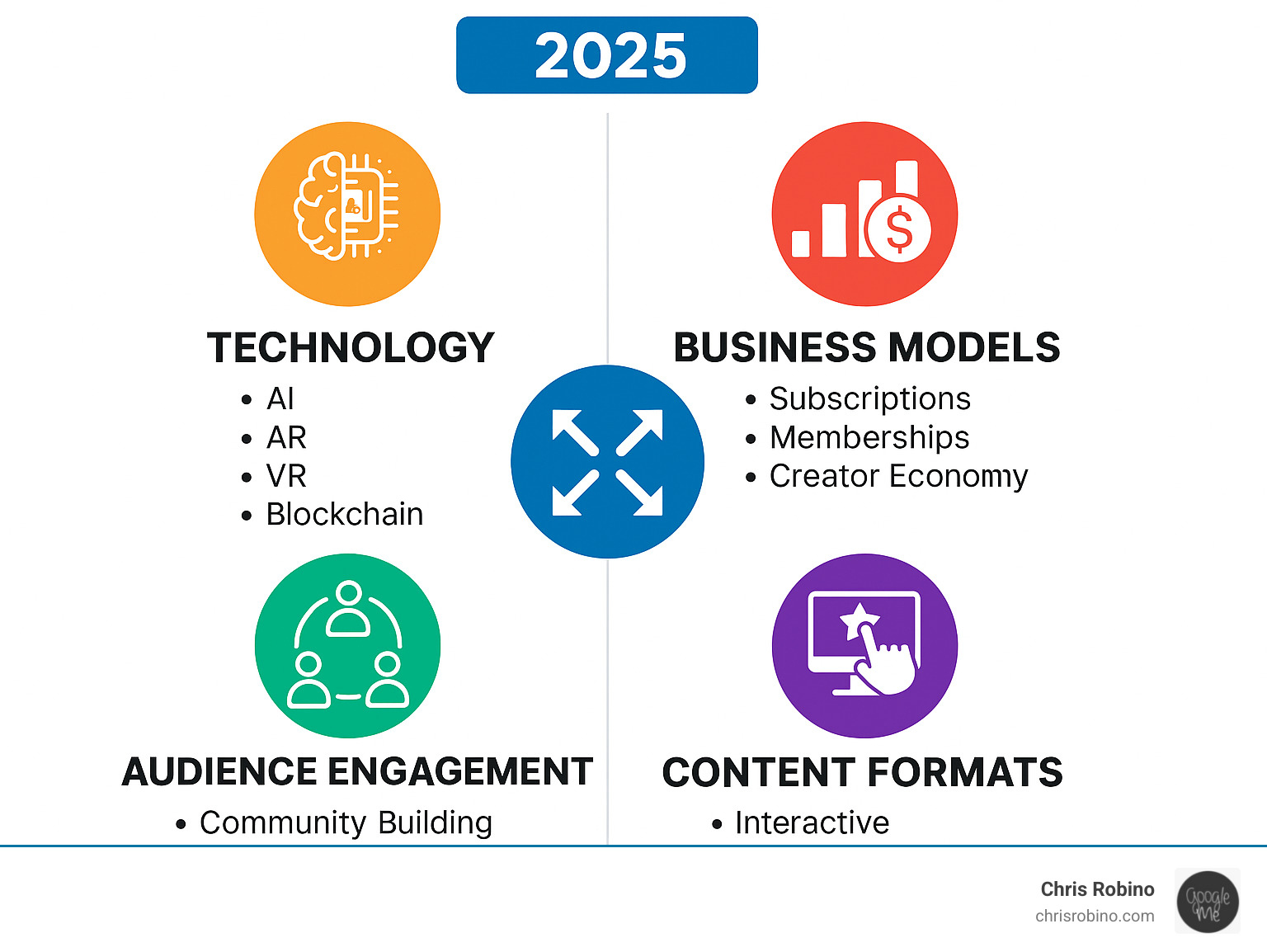Why Innovation in Media Companies is Critical for Survival
Innovation in media companies has become the defining factor for survival. Media organizations are changing through:
- AI-powered content creation and automated journalism.
- Immersive storytelling via AR/VR experiences.
- New business models like creator platforms and community memberships.
- Direct audience engagement through interactive features.
The media landscape is experiencing unprecedented disruption as traditional revenue models crumble. This shift isn’t just about new tech; it’s about reimagining operations. From The Washington Post’s AI tools to Dropout’s niche streaming model, the winners are those who accept change. For large companies, this innovation is also key to advanced SEO, ensuring they dominate search results by meeting new user expectations for interactive and authoritative content.
With the AI in media market projected to soar, failing to innovate means risking irrelevance. I’m Chris Robino, a Digital Strategy Leader and AI & Search Expert. I’ve seen how strategic innovation drives growth, integrating emerging tech while maintaining a core mission.

The Tech Revolution: AI, Immersive Worlds, and the New Content Frontier
The very DNA of media is being rewritten. The lines between creator, distributor, and consumer are dissolving.

Artificial Intelligence is at the heart of this revolution. AI is becoming essential for automated reporting, freeing journalists for in-depth analysis. The Associated Press has used it for years to produce earnings reports, boosting capacity for creative work. AI also boosts data analysis, helping journalists find stories in massive datasets. The Washington Post’s proprietary AI tool, Haystacker, sifts through data to find newsworthy patterns, a custom solution far superior to generic tools. For large media companies, this isn’t just about efficiency; it’s an SEO imperative. AI-powered personalization delivers content that aligns with user intent, a critical factor for ranking in semantic search.
Immersive media like Augmented and Virtual Reality (AR/VR) is creating new storytelling frontiers. Instead of just reading a story, audiences can step inside it. The New York Times has pioneered this with AR journalism, creating deeply personal and interactive experiences. This level of engagement sends powerful positive signals to search engines, indicating high-value content.
Other technologies like blockchain are offering solutions for intellectual property and transparent monetization, while voice technology is reshaping content consumption through smart speakers and voice search. Success comes from embracing these tools strategically. As I’ve learned from years of digital strategy work, large companies must leverage these technologies not just for content, but to build a technical SEO foundation that’s future-proof, aligning with principles like Moving From Ops System to Browser-Based to the Clouds for maximum flexibility and scale.
Rewriting the Rules: Innovative Business Models for Financial Sustainability
The traditional ad-driven model is failing, and with audiences facing “subscription fatigue,” media companies need new ways to create value. This has sparked a boom in the creator economy and niche media, where specialized content finds a direct path to a paying audience.

Creator-centric outlets like Puck News and The Ankler prove that high-value, insider reporting can attract dedicated subscribers. They focus on specific industries, building deep engagement. This strategy is a masterclass in SEO for large companies: by developing deep expertise in a niche, they build immense topical authority, signaling to Google that they are the definitive source for that subject. Worker-owned models like 404 Media build further trust by aligning journalist and audience interests.
Beyond a simple paywall, the most innovative companies are building ecosystems. Tortoise Media diversifies with exclusive content, merchandise, and podcasts. Outside Interactive blends content with fitness apps and outdoor festivals, creating a lifestyle brand. Non-profits like The 19th News thrive on community donations to fund mission-driven journalism. These models work because they build a loyal community that provides strong user engagement signals—like repeat visits and long session durations—that are heavily weighted in search rankings.
Furthermore, e-commerce is becoming a significant revenue stream. The growth of the social commerce market shows the power of integrating direct purchasing into content. This creates a seamless user journey from findy to conversion, a powerful combination for both revenue and SEO. The key is to experiment and Go Make Mistakes to find what revenue strategies resonate with your specific audience.
For the People, By the People: Audience Engagement and Community Building
In an era of historic media distrust and “news fatigue,” building authentic audience connections is paramount. The old model of broadcasting from on high is dead. Today’s audiences demand to be participants in a conversation.

This is where community building becomes a powerful strategy. It transforms news consumption from a solitary activity into a collaborative one. For large media organizations, this is directly tied to SEO success through Google’s E-E-A-T (Experience, Expertise, Authoritativeness, and Trustworthiness) guidelines. Every initiative that builds trust also builds search authority.
Innovative companies are actively working to bridge divides and serve overlooked audiences. The Flip Side fosters bipartisan dialogue, while The 19th News serves women and marginalized communities with mission-driven journalism. RocaNews combats negativity with factual, non-partisan news. These companies succeed by serving niche communities with purpose, building the kind of loyalty and authority that search algorithms are designed to reward.
Transparency is another key pillar of trust. The Washington Post’s experiment inviting sources to annotate stories is a bold move toward openness. Similarly, collaborative journalism initiatives, like the Investigative Journalism Foundation’s public database or the Stars4Media program’s cross-border projects, build credibility. By making processes visible and working together to fight misinformation, these organizations are actively demonstrating their trustworthiness, a crucial component of E-E-A-T that underpins long-term SEO performance. As highlighted in Media Industry Trends 2024, prioritizing genuine engagement is the path to a sustainable future.
The Future of Innovation in Media Companies: Challenges and Collaborations
The road ahead for media companies is paved with both opportunities and challenges. Financial sustainability, the high cost of tech integration, and the erosion of trust due to misinformation remain significant problems.

Perhaps the biggest challenge is the inertia within large organizations. As noted by experts, many traditional media companies have been slow to adapt to mobile-first audiences and the agile strategies required to compete. This inertia is a major roadblock to implementing the kind of sophisticated, cross-departmental SEO strategies needed to win in today’s search landscape. The gap between recognizing the need for change and successful implementation, as highlighted in this special report on technology adoption, is where many companies get stuck.
However, these challenges are also creating immense opportunities for those with The Soul of an Entrepreneur. The most powerful solution emerging is collaboration. The smartest companies know they can’t go it alone. European programs like Stars4Media fund projects where media organizations work together on shared challenges, from managing data more efficiently to fighting misinformation with shared verification tools.
These technology and resource-sharing partnerships allow media companies to focus on their core journalistic mission while integrating cutting-edge technology. For large corporations, this is a strategic way to accelerate innovation and SEO performance without having to build every capability in-house. Networks like the Global Alliance for Media Innovation foster this collective intelligence, proving that cooperation is a key strategic advantage for a sustainable future.
Frequently Asked Questions about Innovation in Media Companies
Let’s tackle the key questions about where the industry is heading.
What is the most significant technological innovation impacting media companies today?
Artificial Intelligence is the undisputed game-changer. AI is automating content creation, personalizing user experiences, and providing deep audience analytics. For large companies, its most critical role is in enhancing SEO. Generative AI helps scale content that meets specific user intents, while analytical AI uncovers patterns in search data to guide strategy. Tools like The Washington Post’s AI for investigative journalism, as detailed in reports on how the Washington Post harnesses AI, show how it can uncover unique stories that build authority and attract high-quality backlinks.
How are new media companies achieving financial sustainability?
They are building diversified revenue models centered on high-value audiences. The key is moving beyond advertising to accept premium subscriptions, memberships, and niche content. Companies like Puck News prove that specialized content can command premium prices. This approach is a powerful SEO strategy: by serving a niche deeply, a company builds topical authority, making it easier to rank for valuable long-tail keywords. This focus on a specific audience builds a loyal community that provides strong engagement signals for search engines.
What is the role of community in the future of media?
Community is essential for survival, moving media from a broadcast model to a conversational one. Its primary role is building trust, which is the core of Google’s E-E-A-T guidelines and a crucial factor for SEO success. A strong community reduces subscription churn and provides direct feedback for content improvement. Furthermore, an engaged community that interacts with content sends powerful signals to search engines about its quality and relevance. Platforms like the Subtext SMS platform that foster direct publisher-reader connections are invaluable for building the loyalty that underpins both financial sustainability and search authority.
Conclusion
The media industry is being completely reimagined. The innovations we’ve explored—from AI-driven journalism and immersive storytelling to creator-centric business models and community-driven engagement—are not just trends. They are the new foundations for a sustainable future.
The common thread is adaptability. The media companies thriving today are those that view challenges as opportunities. They understand that innovation isn’t just about adopting new tech; it’s about fundamentally rethinking how to create and deliver value to an audience. For large companies, this means integrating these innovations into a cohesive digital strategy that drives search visibility and market leadership.
As someone who has spent two decades guiding organizations through digital change, I know that strategic innovation turns challenges into competitive advantages. It’s about combining technological sophistication with a deep understanding of your audience to build a business that serves both your community and your bottom line.
If you’re ready to make innovation a core driver of your media organization’s growth and search dominance, let’s connect. Through our Business Consulting Firm, we help companies implement strategies that deliver real results. Let’s discuss how to drive innovation in your media venture and build a resilient future.
